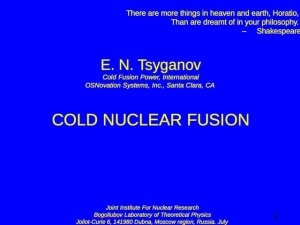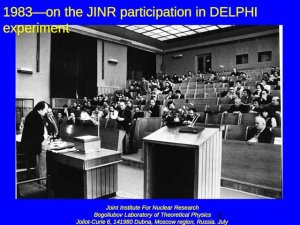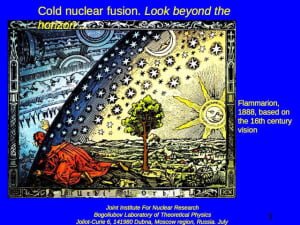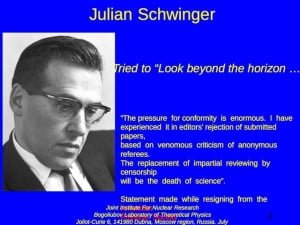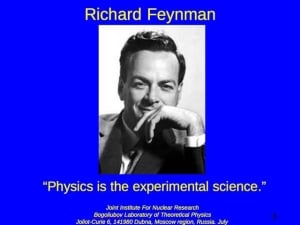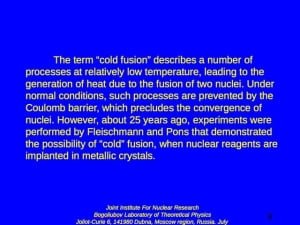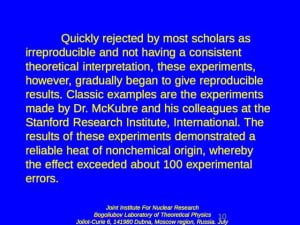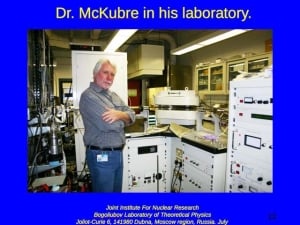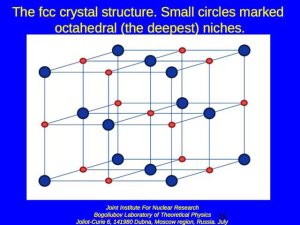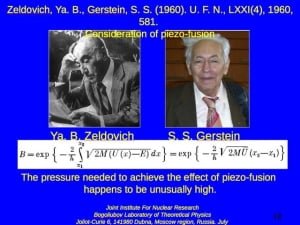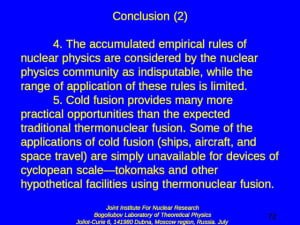Dr. Edward Tsyganov of Cold Fusion Power presented a Cold Nuclear Fusion Seminar at N. N. Bogolyubov Laboratory of Theoretical Physics (BLTP) 2014 in Dubna, Russia.
Powerpoint files of the presentation can be found here.
A video news report on the event was posted by the Joint Institute for Nuclear Research JINTV here and on Youtube here
A transcript of the video news report was provided by Scientific Information Department JINR 2014 and is reproduced below:
The seminar, which dealt with cold nuclear fusion, took place at the Laboratory of Theoretical Physics of the Joint Institute for Nuclear Research. In his report, Professor Edward Tsyganov gave a possible explanation of the effects observed in numerous experiments. The scientist was asked many questions. Currently, physicists believe that there is no conclusive evidence for the existence of cold fusion. However, cold fusion studies continue to be carried out in various countries in order to discover and secure an inexhaustible supply of nuclear energy.
It all started with a report by chemists Martin Fleischmann and Stanley Pons on electrochemically induced nuclear fusion—the conversion of deuterium to tritium or helium through electrolysis using a palladium electrode. This report, which appeared in March 1989, caused quite a stir. The scientists observed neutron emission and the recovery of large amounts of heat, which are signs of nuclear processes. However, the scientific community believes that their claims are incomplete and inaccurate. So-called cold fusion established itself as a pseudoscience; however, after a public demonstration of the experiment using electrochemical cells in 2008 by Yoshiaki Arata of Osaka University, discussions on cold fusion began to appear again.
Known nuclear fusion reactions—thermonuclear reactions—take place in plasma at temperatures of millions of degrees Kelvin. So-called cold nuclear fusion assumes the possibility of nuclear fusion reactions in chemical (atomic and molecular) systems without significantly heating the working substance. However, most chemists and physicists are trying to find an alternative (non-nuclear) explanation for the phenomenon.
Professor Edward Tsyganov remarked that, when saturating conductive crystals with deuterium atoms, the presence of free electrons in the crystal potential niches leads to a ban for the unexcited deuterium atoms to occupy these niches. At the same time, even the first excitation level of deuterium atom removes this ban. When all of the potential niches have already been filled by deuterium atoms at least once, further saturation of a crystal with deuterium atoms gives rise to twin clusters of atoms in one such niche.
In most of these clusters, deuterium nuclei are pulled together to distances of 1/10–1/20 of the nominal size of these atoms. The zero level of quantum mechanics vibrations in the adjacent deuterium nuclei quickly leads to the penetration of the two deuterium nuclei through the reduced Coulomb barrier. The spatial orientation of the excited deuterium atoms in the crystal lattice is strictly determined with respect to one of the crystal lattice’s spatial directions.
The report also discussed the further dissipation of energy during the transition from the excited state of 4He* to the ground state–formed nuclei of 4He (~24 MeV).
This was the second seminar on the topic of cold fusion at JINR. About a year and a half ago, Professor Edward Tsyganov gave a similar talk at JINR. Both then and now, his report “DD fusion in conducting crystals” has caused heated debate.
–Scientific Information Department JINR 2014
Editor: Inna Orlova
Video: Igor Belvedersky
Related links:


